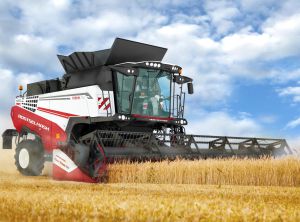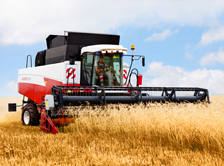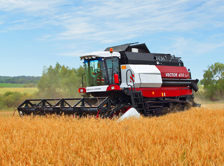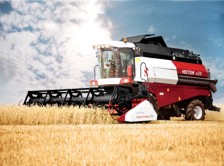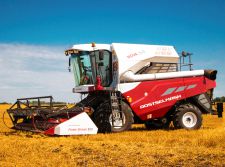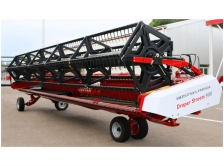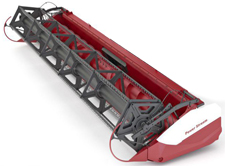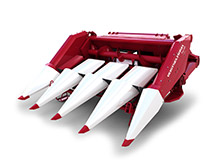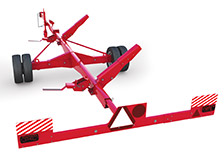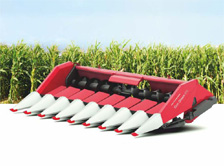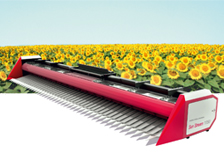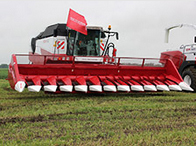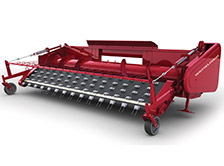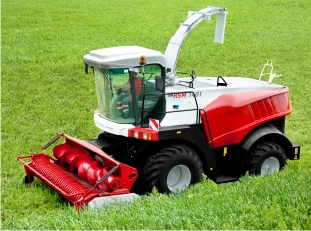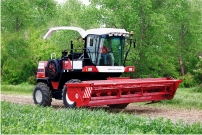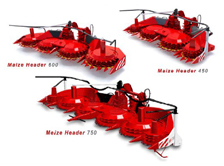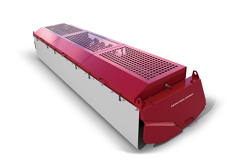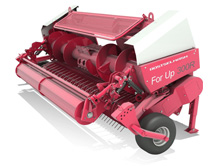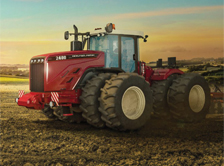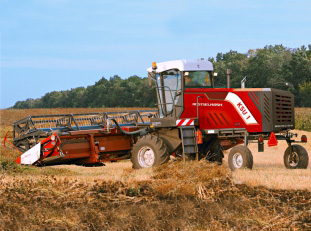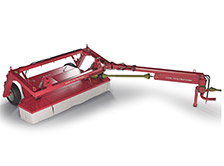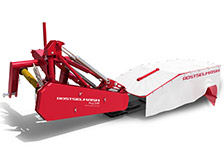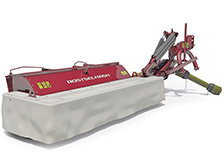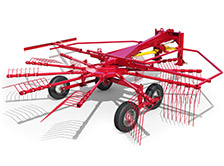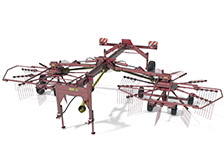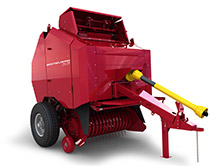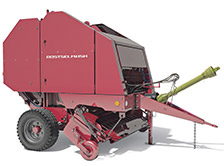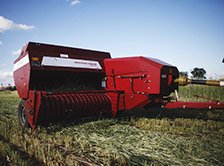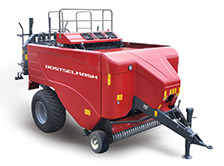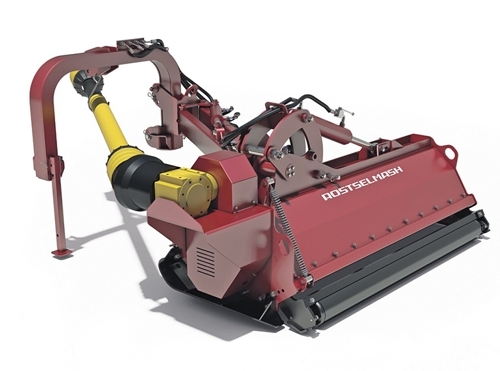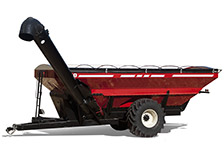People of the Great Victory
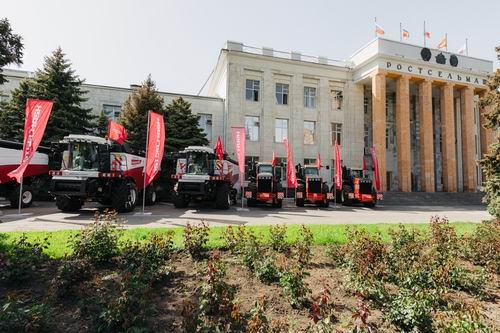
A special page in Rostselmash history is related to the period of the Great Patriotic War. During the War the enterprise and the surrounding village were completely destroyed. However, the enterprise managed to evacuate part of the equipment to Tashkent in order to produce shells and mines for the front line deep in the rear. When Rostov-on-Don was liberated from the Nazis, the war was still going on in the USSR territory, and Rostselmash was already producing its first products right in the ruined city. Its employees helped forge the Victory in the rear and at the front, in spite of any difficulties.
Rostselmash during the War: Forging Harvesters into Shells
The War reached Rostov four months after it began. By October 1941, the Germans defeated the Southern Front troops in Donbas and entered the route of approach to Rostov. Equipment dismantling and shipping to Tashkent began in Rostselmash on October 13. Evacuation is a titanic work that has surpassed the enterprise construction in its scope and speed. Its entire territory turned into a continuous stream of moving loads, which were sent by trains and aircrafts. The Rostselmash evacuation required more than 3,500 cars.
In Tashkent, sites were selected in different parts of the city, but they were not enough. Part of the equipment had to be sent to the city of Chirchik (60 km from Tashkent). Thus, four branches of Rostselmash were formed in Uzbekistan - three in Tashkent and one in Chirchik. On the 33rd day (Rostov had survived a short occupation at that time) after the equipment arrived in Tashkent, Rostselmash began to produce products for the front line. Installation of machines was carried out in the open air or in hastily adapted sheds and other buildings. On the 35th day of continuous operation, the first cast iron was melted.
The workshops of the enterprise relocated to the rear have grown in a three months time on an area of 12 thousand square meters. At that time 82 mm and 120 mm mines, warheads for missile shells (Katyusha), 50 kg, 100 kg and 250 kg high-explosive bombs were produced here. Since the threat of an attack on Rostov was still relevant, Tashkent production continued its work. This was far-sighted, since on July 24, 1942, the Nazi troops and their allies occupied Rostov-on-Don again. This time it lasted for a long time - for almost eight months. During this time, about 12 thousand houses were destroyed in the city, more than 40 thousand people were killed, more than 50 thousand Rostovites were sent to Germany for forced labour. Almost all the city enterprises were destroyed, including Rostselmash and its village. But on February 14, 1943, during an offensive operation of the Red Army, the city was completely liberated from the invaders.
During the retreat, the Germans were systematically blowing up and burning Rostselmash and the village for eight days. All workshops, residential buildings, the building of the Institute of Agricultural Machinery industry turned into heaps of ruins ... Material damage to the enterprise amounted to over 180 million rubles. However, the first 33 industrial machines began to work in the ruined city 10 days after the liberation. Rostselmash restoration required clearing 150 thousand cubic meters of rubble, laying 21 million bricks, 37 thousand cubic meters of concrete, assembling 8 thousand tons of metal structures, laying 185 thousand cubic meters of roofing. In a short time, 145 thousand square meters of production space were commissioned. At the same time, preparations were launched for manufacturing military products, and tank, tractor, and vehicle repair was arranged.
Heroes of the Soviet Union
In the early days of the War, hundreds of Rostselmash employees volunteered for the front. On July 10, 1941, the Rostov rifle regiment of people’s volunteer army was formed. Two of its troops consisted entirely of Rostselmash workers. Workers also fought in Mikhail Trifonov’s (Yugov’s) partisan unit. Thousands returned from the fronts with insignias and medals. 14 people were awarded the highest award of the Motherland – the Gold Star of the Hero of the Soviet Union, more than 100 people were awarded state awards for work in the rear.
Those who came to Rostselmash before the war turned out to be excellent soldiers and officers. The enterprise became their first school of life. Having begun a military career during the Great Patriotic War, they worthily manifested themselves and subsequently became heroes. Describing their actions, we recall the Rostselmash traits - diligence, thirst for team success, the will to win and dedication.
For example, Mikhail Gakkel was endowed with such character traits. After school, he entered Rostselmash, where he mastered the profession of a turner and has been working here from 1936 to 1939. In 1939 he was drafted into the Red Army. He encountered the War as a sergeant already. He was awarded the Order of the Red Banner for military dedication, courage and bravery in assaulting enemy positions, two orders of the Red Star, the medal "For the Defence of the Caucasus", the Gold Star of the Hero of the Soviet Union (posthumous). He died in June 1944 in the battles for Belarus liberation. A street in Rostov-on-Don was named after him.
Semyon Aleshin, who has been working at Rostselmash as a mechanic before the War. In 1932 he was drafted into the army for duty in the field. After graduating from the Kachin military aviation school, he became a combat pilot. He fell to the military operation, known in Soviet historiography as the Polish campaign of the Red Army, which resulted in Western Ukraine and Western Belarus incorporation in the USSR in November 1939; as well as the Finnish campaign of 1939-1940. He was awarded two Orders of Lenin. He received the Gold Star of the Hero of the Soviet Union posthumously. Already at the height of the Great Patriotic War, on July 12, 1942, while performing a combat mission in the vicinity of the Lembolovo railway station (Leningrad Region), he drove his damaged plane into the enemy’s artillery guns.
Mikhail Govorov, who came to Rostselmash as a toolmaker in the early 30s of the last century. He joined the Red Army in 1935. During the Great Patriotic War he was the commander of the 533th anti-tank artillery regiment. Already having the rank of a major, he distinguished himself as a regiment commander in breaking through the enemy’s defence on the Vistula River. In January 1945, during unit crossing under his command, many enemy fortifications were destroyed, tanks and assault guns were destroyed. He was awarded the title Hero of the Soviet Union for the exemplary performance of combat missions, as well as for the demonstrated courage and heroism in 1945.
Pioneer builders of Rostselmash were among the war heroes. It is noteworthy that many of them subsequently became pilots. For example, Viktor Yevdokimov, who worked at the enterprise as a mechanic and welder in 1928-1934. Then he entered a flight school. During the war he served in a long-range bomber aviation regiment and flew missions on a DB-3A aircraft to the enemy’s rear lines. Took part in the Battle of Stalingrad and the Battle of Kursk. During February-April 1944 he completed 226 sorties (he had 850 sorties in total), and trained five flight crews. He obtained the title of Hero of the USSR in August 1944. One of the streets in Rostov-on-Don is named after him.
Since childhood, which fell on the revolutionary years, Pavel Savchenko first worked as an apprentice in a workmen's cooperative association, and then as a rebar fitter during Rostselmash construction. At the call-up of the Komsomol, he was sent for training to the 1st Bataysk flight school of Civil Aviation and graduated in 1933. He became a pilot of civil aviation, was a Stakhanovite of Aeroflot. During the war, he became a pilot of bomber aircraft, made 503 sorties to the enemy rear for bombing strategically important targets. Delivered cargo and ammunition to the partisans. He died during a combat mission, delivering cargo for a partisan unit.
Another Rostselmash pioneer builder is Alexander Zagorinsky. He worked at the enterprise as a mechanic starting the very first days (1929 - 1938). Then he served in the border troops of USSR NKVD as a machine gunner. In the midst of the Finnish campaign in the winter of 1940 he entered into battle with the enemy near the village of Uoma, inflicting heavy losses on him. He was seriously injured, but continued to fight. After the Finnish campaign, he was demobilized for health reasons, returned to Rostov-on-Don, worked as a foreman at Rostselmash. He suddenly died from wound after-effects in August 1941.
From March 1933 to May 1934, Vladimir Kolesnikov was studying the profession of a turner at the factory-apprenticeship school at Rostselmash. In the Red Army starting 1935. He served as an accountant, was a leader of a rifle company. In May 1941 he graduated from the Astrakhan Rifle and Machine Gun School. He received the Star of the Hero of the Soviet Union for the fact that a machine-gun company under his command destroyed 300 enemy soldiers and officers in battle, crushed 14 enemy machine-gun points in the battle on July 5, 1943, in the vicinity of the village of Maslova Pristan (Shebekinsky district of Kursk region, now Belgorod region). Participated in the Battle of Stalingrad, of Kursk. He died a hero's death in Czechoslovakia in April 1945. Today, vocational school No. 1 in Rostov-on-Don bears his name.
Vasily Yakovlev, after finishing seven classes and a factory-apprenticeship school, worked at Rostselmash as a mechanic in the harvesting machine workshop from 1934 to 1937. He fought at the front since June 1941 being an employee of the Internal Troops. Yakovlev’s platoon was one of the first in the regiment to conduct a forced crossing of the Dnieper. In 1944, for the courage and heroism demonstrated during the military operation he received the title of the Hero of the Soviet Union. After the war, he served in the Ministry of Internal Affairs in his native Rostov-on-Don.
Mikhail Kostenko worked as a parquet floor layer in Rostselmash from 1929 to 1932. Then he graduated from the Civil Air Fleet School, the Moscow School of Flight Instructors. During the Great Patriotic War, he fought on the Leningrad front. He carried out 274 sorties to bombard accumulations of military equipment and manpower of the enemy, his important objects. He received the Star of the Hero of the Soviet Union already in 1946 for "courage and heroism demonstrated during combat missions".
Ivan Nechipurenko worked at Rostselmash as a mechanic from 1934 to 1938. Entered the Red Army since 1938. On the fronts of the Great Patriotic War II from May 1943. He graduated from the Volsk Military Aviation Technical School. He fought as a senior pilot and flight commander on the Central, Belorussian and 1st Belorussian fronts. He participated in major war operations, including the Vistula-Oder and Berlin. He made 105 sorties, destroyed 13 tanks, 75 vehicles and many other military equipment of the enemy, up to 400 soldiers and officers. He was awarded the Star of a Hero of the Soviet Union in 1946 for exemplary performance of combat missions of command on the front of struggle against Nazi invaders.
Pavel Petikin worked as a layout specialist at Rostselmash from 1932 to 1936 after graduating from factory-apprenticeship school, and then was drafted into the army. He graduated from the Rostov Artillery School. By October 1943, Petikin commanded the battery of the 150th guards artillery regiment. He distinguished himself during the battle of the Dnieper. On October 5, 1943, he personally destroyed two tanks and one armoured car in a battle near the Borodaevka village of the Verkhnedneprovsky District of the Dnipropetrovsk Region. At a critical moment in the battle, he raised his comrades to attack, forcing the retreat of enemy infantry. On October 26, 1943, Senior Lieutenant Petikin was awarded the title of the Hero of the Soviet Union with receiving the Order of Lenin and the Gold Star medal. He fought in Stalingrad, on the Kursk Bulge, forced crossing of the Dnieper. More than once participated in hand-to-hand combats.
Vladimir Solyanik worked as a mechanic and an acceptance inspector for Rostselmash from 1932 to 1941, was a top-quality staff member. Then he went to aviation. In 1938 he graduated from the Stalingrad Military Aviation Pilot School. He served as a junior and senior pilot of the 8th long-range bomber regiment of the 2nd separate army, as a flight commander of the 139th long-range bomber regiment of the 5th aviation corps of the Far Eastern Front. By May 1945, he made 212 sorties (207 of them at night) to bombard military-industrial facilities in the enemy rear. He was awarded the Star of a Hero of the Soviet Union in 1946 for “exemplary performance of combat missions of command on the front of struggle against Nazi invaders and demonstrated courage and heroism”.
Lazar Chapchakhov, having finished 9 grades of the school, entered Rostselmash, where he worked as a digger, hammer-man, electrician from 1930 to 1933. In 1934 he graduated from the Voroshilovgrad Military School of Pilots, later - courses of commissars at the Kharkov Military School of Pilots. He fought on the Leningrad front. He made 368 sorties. Chief enlistment officer of the squadron of the 38th Fighter Aviation Regiment Chapchakhov particularly distinguished himself in battles in the autumn of 1941, when, fighting with the enemy, he destroyed several enemy bombers. On April 5, 1942, Chapchakhov took charge of the 416th Fighter Aviation Regiment, and died a week later, on April 13. This happened at the Kresttsi airfield in the Leningrad Region when trying to prevent an airplane accident due to unsuccessful landing of a young pilot. On July 21, 1942, he was posthumously awarded the Gold Star of the Hero of the Soviet Union for exemplary performance of combat missions and demonstrated courage and heroism.
Rostselmash also appreciates and treats as heroes those who came to the enterprise after the war. They brought their experience of labour management in various areas of the enterprise.
For example, Sergei Maly, who fought in the rifle regiment during the war years. He was a participant in the battles on the Mius Front, near Stalingrad, in Kuban, on the Don, forced crossing of the Dnieper, Poland liberation. On the night of November 26, 1943, his company stormed the dominant height beyond the Dnieper. Maly was wounded, but did not leave the battlefield. He was awarded the Golden Star of the Hero of the Soviet Union. He rose to the rank of colonel and in 1966 left military service. After the service, he worked at Rostselmash as deputy chief of civil defence staff.
Perhaps the most famous hero, who became a legend after his death, is Alexey Berest. Soviet officer who went through the entire war from a common soldier to a second in battalion commander. During the Berlin mission, he was among those who raised the Victory Banner over the Reichstag. He was awarded the Orders of the Red Star, World War first class, the Red Banner, medals "For the victory over Germany", "For the liberation of Warsaw", "For the capture of Berlin." After the war, he worked at Rostselmash as a sandblaster in a steel-casting shop. He died in 1970, saving a child from under a train at the Selmash railway station. There is a memorial in Rostselmash in his honor, and a monument has recently been erected in Rostov-on-Don. In 2005, he was awarded the title of the Hero of Ukraine.
The Great Patriotic War Veterans
In extreme situations, a person starkly demonstrates those traits that are not noticeable in ordinary situations. Rostselmash workers showed dedication, courage and bravery in the War. Moreover, there were persons who could avoid military operations due to a high position occupied in the enterprise. However, they have chosen to stay and accept the battle. One of them was Timofey Zolotov, Party Committee Secretary of the enterprise. Despite having the exemption from active duty, he voluntarily went to the front. During the war years, he went through the battles from Stalingrad to the Baltic as part of a mortar squad. He was wounded near Koenigsberg by a fragment of a blown mine, which pierced the breast pocket of the service shirt and was stuck in the party membership card lying there. It saved his life. Due to injuries, he subsequently lost his leg. After the war, he was sent to Rostselmash, worked at the co-generation power plant and in the first forging shop.
We will list other names.
Vasily Arzhanov was awarded the medals “For Courage”, “For Victory over Germany”, “Order of the Patriotic War”. Before the war he received diploma No. 1 of the College of Agricultural Engineering specialized for Rostselmash. He fought near Stalingrad as a shooter of a rifle regiment, liberated Czechoslovakia. He participated in the battle for Berlin. After the war, he managed a team of machinists, who manufactured parts for combines "Stalinets 1", "Stalinets 6". He was called "clever pair of hands" and "Rostov lefty". He was the author of numerous brain-teaser inventions.
Evgeny Sadyrov is a participant in the Victory Parade in Moscow in June 1945. Holder of 3 Orders of the Patriotic War of classes I and II, Red Star, Order of Glory of class III, Red Banner of Labour. He took part in battles as a participant of cadet rifle brigade along with Caesar Kunnikov marine detachment. He landed on Malaya Zemlya in Novorossiysk. He liberated Crimea, Transcarpathia, Czechoslovakia, Poland, Germany. He worked at Rostselmash since 1949, first in the grey cast iron workshop, then in enterprise training centre.
Mikhail Rakitin is one of the first builders of Rostselmash (1926-1931), and then one of its workers: from 1930 to 1941 he worked as a heat treatment operator at the malleable iron workshop, which was one of the first to be built in 1929. He went to the front as a volunteer. He fought in the airborne regiment. He was awarded the Order of the Red Star.
Alexander Kudlaenko was one of the founders of the Rostselmash football club, one of the best players of the team in the 1930s. He worked at the enterprise from 1930 to 1975. He participated in many all-Union tournaments. He was awarded the Orders of The Patriotic War of classes II and II, Red Star, Badge of Honor. Foreman of the first Komsomol-and-youth crew of the combine harvester shop. In the Great Patriotic War he served as the senior political instructor of the reconnaissance company, machine-gun company. Having returned to Rostselmash, held leadership positions, revived football.
Alexander Presich – a Soviet officer, pilot of naval aviation, guard captain, flight commander. Awarded 2 orders of the Red Banner. He worked for Rostselmash from 1933 to 1937. Awarded 2 orders of the Red Banner. He went to aviation on a Komsomol call from the enterprise. Member of air battles from the first days of the War. He participated in the Crimea liberation. He died during the liberation of Sevastopol in an air battle with enemy fighters in April 1944.
Grigory Meltzer is a roughrider. He was awarded the orders of the Patriotic War classes II and II, the Red Star, medals "For the defence of Moscow", "For the liberation of Warsaw", "For the capture of Berlin", "For the Victory over Germany". He fought under the command of commander Isa Pliev. He travelled from the Caucasus to Moscow and Berlin on his horse Rumba, signed on the Reichstag. Worked for Rostselmash starting 1937 after coming from an orphanage. After the war he returned to the enterprise. He worked for 36 years as a turner-borer in the experimental workshop.
Fraim Grinberg volunteered for the front. He fought till a serious injury. He participated in the creation of the new Cultural Centre “Rostselmash”, which was built in 1961 on the Combine Builders Square in Rostov-on-Don. He became its first director. An initiator of creating many creative groups that brought glory to the company in the USSR and 40 countries of the world. Honoured Cultural Worker of the USSR.
Yakov Rotin is a Soviet officer. A political officer of a tank battalion. He was awarded 2 Orders of the Red Banner, 2 Orders of the Red Star, the Order of the Patriotic War of class II, the Czechoslovak Battle Cross. He liberated Rostov-on-Don, Donbass, Ukraine, the Carpathians, Poland. He was a commander of an air assault group. Fought hand to hand. Saved the Auschwitz archive. Honorary citizen of several European cities. After the war, he established public diplomacy in Europe, worked as deputy director of the Rostselmash Cultural Centre.
Alexander Kobelev – a pioneer builder of Rostselmash. He went all the way from a handyman to the head of the workshop. Honorary Rostselmash worker. He was awarded the Orders of the Patriotic War of classes I and II, the Order of the Red Star, Lenin, the Red Banner of Labour. During the Great Patriotic War he served as an artilleryman. He liberated Rostov-on-Don from the Nazis in 1943. Personally destroyed more than 20 tanks and armoured personnel carriers. He travelled from Rostov to Germany.
Lidia Kuznetsova, a sanitary doctor, supervised medical care at Rostselmash. In 1942 she was sent to the 161st military unit of the rifle cadet brigade of the second rifle battalion. Went through the North-Western Front, took part in the battles in Latvia, Belarus and ended the war in Romania. After the War, in 1951-1984, she worked as the Chief Medical Officer of the sanitary and epidemiological station of Pervomaisky district. Based on her recommendations, measures were taken to improve the labour of workers at Rostselmash, which significantly reduced the level of occupational diseases.
Trofim Koveshnikov is a professional military man. Head of the Political Department of an Air Force Fighter Regiment. He participated in the defence of Moscow within air defence fighter aviation units. He took part in the battles as a member of Northwest, 3rd Baltic Front. Participant in the assault on Koenigsberg. He worked for Rostselmash from 1961 to 1987 as a deputy head of the human resources department. He was sent on business trips to the republics of Central Asia for hiring specialists and workers for the Rostselmash Komsomol shock-work construction in the 1970s (workshops were built for the production of Niva).
Children of war
Perhaps the most touching page in the military history of the enterprise is connected with the “children of war”. They worked in the rear on a level with adults, and some survived the occupation, helping the partisans in the most difficult period. In many ways, their actions determined the future of Rostselmash.
For example, a wartime worker Oleg Boldyrev. At the age of 9, he and his family were evacuated to Tashkent, where he worked as a mechanic-machine operator using the evacuated Rostselmash equipment. He fulfilled the norm for adults at the site of welding and assembling bomb detonators. He reached the working part of the machine only after placing several boxes under his feet. After re-evacuation to Rostov, he graduated from school, worked as a mechanic in Rostselmash. At the same time he was engaged in vocals at the Cultural Centre and subsequently became a frontman of the Balalaika band. His beautiful tenor was heard in 40 countries of the world.
The real little war hero was Anatoly Podushko. During the occupation of Rostov in 1942, when the Nazis killed his father and his mother died of grief, 13-year-old Tolik Podushko and his 17-year-old sister Lyusya became members of a partisan detachment led by Mikhail Trifonov (Yugov). He helped in the release of soldiers and officers of the Red Army from a detention camp in Rostov. He wrote and posted leaflets with information about the situation on the fronts. After the war, he worked for 50 years as a turner, equipment adjuster at Rostselmash. He was awarded the Order of the Patriotic War, medals “For the Victory over Germany”, “Partisans of the Patriotic War” class II, “For the Defence of the Caucasus”.
No one dies for good
As far as Rostselmash is concerned, the enterprise began producing spare parts for agricultural machines in 1943 already, and in 1946 began to produce powerful five-body tractor ploughs. In 1946, Rostselmash designers A. Krasnichenko, V. Proshunin, I. Popov created the drawings of the new post-war "Stalinets 6" combine harvester. The first samples of these machines were assembled in the harvesting machine workshop on April 30, 1947. The developers of the new design received the title of Awardees of the Stalin Prize.
War energy was so enormous and had such inertia that it could only be “switched” to peaceful construction, as the famous sociologist and historian Sergei Kara-Murza wrote. It’s tension was similar to the war one: in 1948 the country reached, and then surpassed, the pre-war level of industrial production, which by normal standards is unthinkable. Rostselmash in 1949 reached pre-war production volumes, starting a new stage of development.


